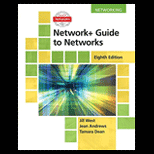
Computer Networking: A Top-Down Approach (7th Edition)
7th Edition
ISBN: 9780133594140
Author: James Kurose, Keith Ross
Publisher: PEARSON
expand_more
expand_more
format_list_bulleted
Question
Given an undirected graph G, and a path P, we want to verify that P is a cycle that contains all nodes in the graph (each node occurs on P exactly once, no repetition is allowed).
In numbered steps, describe a polynomial-time verifier that checks if a given path P has the described properties (meaning that it is a cycle and it contains all nodes in the graph, with each node appearing on the path exactly once).
(Hint: you can think of it in terms of this question: what does the verifier need to check to ensure that the path P has the described properties?).
Expert Solution
This question has been solved!
Explore an expertly crafted, step-by-step solution for a thorough understanding of key concepts.
Step by stepSolved in 2 steps

Knowledge Booster
Similar questions
- Give an example of an application of a graph in computer science.Indicate whether the graph is directed or undirected. What significance, if any, does the presence of cycles have in this graph?Also indicate what significance, if any, there is to whether the graph is connected. Please provide reference at the end also and dont copy from other sitesarrow_forwardWe are given an undirected connected graph G = (V, E) and vertices s and t.Initially, there is a robot at position s and we want to move this robot to position t by moving it along theedges of the graph; at any time step, we can move the robot to one of the neighboring vertices and the robotwill reach that vertex in the next time step.However, we have a problem: at every time step, a subset of vertices of this graph undergo maintenance andif the robot is on one of these vertices at this time step, it will be destroyed (!). Luckily, we are given theschedule of the maintenance for the next T time steps in an array M [1 : T ], where each M [i] is a linked-listof the vertices that undergo maintenance at time step i.Design an algorithm that finds a route for the robot to go from s to t in at most T seconds so that at notime i, the robot is on one of the maintained vertices, or output that this is not possible. The runtime ofyour algorithm should ideally be O((n + m) ·T ) but you will…arrow_forwardThe following is a graph theory problem: Suppose we have a graph A = (X, Y) and a subgraph of A, which is expressed as B = (x, y). x is an element of X and y is an element of Y. A subgraph is plainly described as a graph obtained from A by removing vertices &/or edges. For every following statement determine whether it is true or false. Explain or provide counterexample. Be careful when answering the following questions to leave edges that have their endpoints in B. (i) If A is connected then B is connected (and vice versa: If B... then A) (ii) If A is simple graph then B is simple graph (and vice versa: If B... then A) (iii) If A contains a cycle then B contains a cycle (and vice versa: If B... then A) (iv) If A is a tree then B is a tree (and vice versa: If B... then A)arrow_forward
- One can manually count path lengths in a graph using adjacency matrices. Using the simple example below, produces the following adjacency matrix: A B A 1 1 B 1 0 This matrix means that given two vertices A and B in the graph above, there is a connection from A back to itself, and a two-way connection from A to B. To count the number of paths of length one, or direct connections in the graph, all one must do is count the number of 1s in the graph, three in this case, represented in letter notation as AA, AB, and BA. AA means that the connection starts and ends at A, AB means it starts at A and ends at B, and so on. However, counting the number of two-hop paths is a little more involved. The possibilities are AAA, ABA, and BAB, AAB, and BAA, making a total of five 2-hop paths. The 3-hop paths starting from A would be AAAA, AAAB, AABA, ABAA, and ABAB. Starting from B, the 3-hop paths are BAAA, BAAB, and BABA. Altogether, that would be eight 3-hop paths within this graph. Write a program…arrow_forwardConsider an undirected graph G with 100 nodes. The maximum number of edges to be included in G so that the graph is not connected isarrow_forwardWrite a program RandomSparseGraph to generate random sparse graphs for a well-chosen set of values of V and E such that you can use it torun meaningful empirical tests on graphs drawn from the Erdös-Renyi modelarrow_forward
- Write a function in a directed graph represented by adjacency lists that returns true (1) if an edge exists between two provided vertices u and v and false (0) otherwise.arrow_forwardA digraph, G, is strongly connected, if each cycle in G has even length. True or False?arrow_forward1. Run DFS-with-timing on this graph G: give the pre and post number of each vertex. Whenever there is a choice of vertices to explore, always pick the one that is alphabetically first. 2. Draw the meta-graph of G. 3. What is the minimum number of edges you must add to G to make it strongly connected (i.e., it consists of a single connected component after adding these edges)? Give such a set of edges. b.arrow_forward
- 5. (This question goes slightly beyond what was covered in the lectures, but you can solve it by combining algorithms that we have described.) A directed graph is said to be strongly connected if every vertex is reachable from every other vertex; i.e., for every pair of vertices u, v, there is a directed path from u to v and a directed path from v to u. A strong component of a graph is then a maximal subgraph that is strongly connected. That is all vertices in a strong component can reach each other, and any other vertex in the directed graph either cannot reach the strong component or cannot be reached from the component. (Note that we are considering directed graphs, so for a pair of vertices u and v there could be a path from u to v, but no path path from v back to u; in that case, u and v are not in the same strong component, even though they are connected by a path in one direction.) Given a vertex v in a directed graph D, design an algorithm for com- puting the strong connected…arrow_forwardCan you help me solve this exercise? Please note that the greedy approach described in the advice paragraph does not work.arrow_forwardI have a directed graph with N nodes. How can I tell if the graph has a cycle? Your answer should be an algorithm in English. It is nice but not essential for you to give the name of the algorithm. You should describe how the algorithm works.arrow_forward
arrow_back_ios
SEE MORE QUESTIONS
arrow_forward_ios
Recommended textbooks for you
 Computer Networking: A Top-Down Approach (7th Edi...Computer EngineeringISBN:9780133594140Author:James Kurose, Keith RossPublisher:PEARSON
Computer Networking: A Top-Down Approach (7th Edi...Computer EngineeringISBN:9780133594140Author:James Kurose, Keith RossPublisher:PEARSON Computer Organization and Design MIPS Edition, Fi...Computer EngineeringISBN:9780124077263Author:David A. Patterson, John L. HennessyPublisher:Elsevier Science
Computer Organization and Design MIPS Edition, Fi...Computer EngineeringISBN:9780124077263Author:David A. Patterson, John L. HennessyPublisher:Elsevier Science Network+ Guide to Networks (MindTap Course List)Computer EngineeringISBN:9781337569330Author:Jill West, Tamara Dean, Jean AndrewsPublisher:Cengage Learning
Network+ Guide to Networks (MindTap Course List)Computer EngineeringISBN:9781337569330Author:Jill West, Tamara Dean, Jean AndrewsPublisher:Cengage Learning Concepts of Database ManagementComputer EngineeringISBN:9781337093422Author:Joy L. Starks, Philip J. Pratt, Mary Z. LastPublisher:Cengage Learning
Concepts of Database ManagementComputer EngineeringISBN:9781337093422Author:Joy L. Starks, Philip J. Pratt, Mary Z. LastPublisher:Cengage Learning Prelude to ProgrammingComputer EngineeringISBN:9780133750423Author:VENIT, StewartPublisher:Pearson Education
Prelude to ProgrammingComputer EngineeringISBN:9780133750423Author:VENIT, StewartPublisher:Pearson Education Sc Business Data Communications and Networking, T...Computer EngineeringISBN:9781119368830Author:FITZGERALDPublisher:WILEY
Sc Business Data Communications and Networking, T...Computer EngineeringISBN:9781119368830Author:FITZGERALDPublisher:WILEY

Computer Networking: A Top-Down Approach (7th Edi...
Computer Engineering
ISBN:9780133594140
Author:James Kurose, Keith Ross
Publisher:PEARSON

Computer Organization and Design MIPS Edition, Fi...
Computer Engineering
ISBN:9780124077263
Author:David A. Patterson, John L. Hennessy
Publisher:Elsevier Science

Network+ Guide to Networks (MindTap Course List)
Computer Engineering
ISBN:9781337569330
Author:Jill West, Tamara Dean, Jean Andrews
Publisher:Cengage Learning

Concepts of Database Management
Computer Engineering
ISBN:9781337093422
Author:Joy L. Starks, Philip J. Pratt, Mary Z. Last
Publisher:Cengage Learning

Prelude to Programming
Computer Engineering
ISBN:9780133750423
Author:VENIT, Stewart
Publisher:Pearson Education

Sc Business Data Communications and Networking, T...
Computer Engineering
ISBN:9781119368830
Author:FITZGERALD
Publisher:WILEY